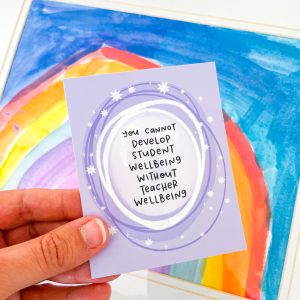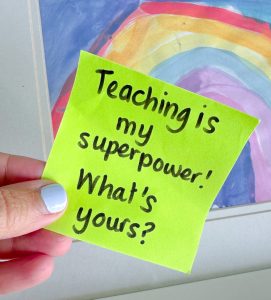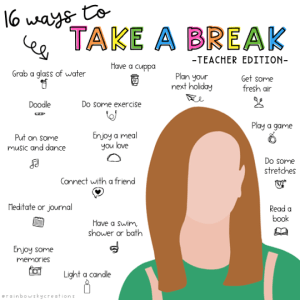Teacher well-being strategies? What are those when you’re in the thick of it?
In the whirlwind of being a teacher, where every minute counts, it’s easy to feel like you’re constantly sprinting a marathon.
But….
What if we told you there’s a better, healthier way to approach your teaching workload?
We have been there, too, on the precipice of burnout, feeling exhausted all the time with little to no patience left in the tank. It is not a healthy or happy place to be, so today’s post is dedicated to turning that around with some teacher well-being strategies.
Let’s delve into five teacher well-being strategies tailored for time management and stress reduction:
1. One Task at a Time
In the fast-paced world of education, we need to remember that it’s not a race.
While deadlines and responsibilities may loom, it’s crucial to maintain a steady pace rather than sprinting at Usain Bolt speed. Focus on tackling one task at a time, embracing the mantra of “slow and steady wins the race.”
Lots of research suggests that multitasking actually slows productivity down.
By prioritising tasks and taking a measured approach, you’ll find that feelings of stress will become less overwhelming—we don’t want to be consistently relying on adrenaline to get us through a normal day.
2. Let Go of “Busy” Culture
Contrary to popular belief, stress and busyness are not badges of honour. While we all strive for success and accomplishment, pushing ourselves beyond our limits only increases anxiety and decreases productivity and efficiency in completing a task.
Instead of glorifying stress, recognise the importance of setting realistic expectations and boundaries.
Remember, your level of busyness does not define your worth and being addicted to ‘productivity- is definitely a thing (we are in the process of recovery, too, when it comes to this teacher well-being strategy).
3. The Art of Saying NO and setting boundaries
Learning to say no can be a powerful tool for reclaiming your time and energy. Rather than overcommitting yourself to every opportunity that comes your way, prioritise your own goals, values and hobbies. It can be hard to say no, but you will not do a great job if you are overcommitted.
By focusing on what truly matters to you (family, friends and things you enjoy outside of teaching), you’ll avoid spreading yourself too thin PLUS you will be filing your cup, which will make you a better teacher.
Try this: Dedicate a month to saying no. It could be around a busy time in your teaching schedule like when it’s back to school, or when reports are due. There is something quite empowering in this teacher well-being strategy of saying no and taking back your time.
4. Embrace Flexibility
A secret teacher superpower is flexibility!
While it’s natural to have expectations for each day, it’s essential to remain flexible and adaptable when challenges and changes pop up—after all, you are working with children! Let go of the need to control every outcome, recognising that some detours may lead to unexpected opportunities for learning and fun.
Remember, as a teacher, you often have more than 25 sets of eyes on you at any given moment. By being flexible and showing your students how things change, you are modelling an important life skill.
5. Redefine productivity
In a culture that glorifies constant productivity, it’s easy to feel guilty for pausing and recharging. However, downtime is not a luxury – it’s necessary to maintain your mental and emotional well-being.
Whether it’s a leisurely lunch break or a brief moment to soak in some sunshine, prioritise self-care without guilt or hesitation. Remember, investing in your own well-being is never a waste of time—it’s an investment in your long-term happiness and success.
Check out these 16 different teacher well-being strategies for taking a break:
As a teacher, your time and energy are precious resources. By adopting these teacher well-being strategies, you’ll not only enhance your effectiveness in the classroom but also a greater sense of balance in your personal and professional life.
Embrace the journey, one mindful step at a time.
What to read next:
A guide to stress-free report writing
Ways to limit staff meeting fatigue
Ways to deal with teacher overwhelm







